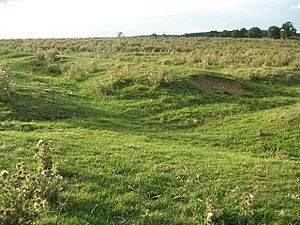Snelshall Priory facts for kids
Snelshall Priory was an old religious building called a priory in Milton Keynes, Buckinghamshire, United Kingdom. It was built around the year 1200. A priory was a type of monastery, which is a home for monks or nuns who dedicate their lives to religious service.
Contents
The Priory's Beginning
Snelshall Priory started when a woman named Sybil d'Aungerville gave land in Tattenhoe to another monastery called Lavendon Abbey. Monks from Lavendon Abbey, who were known as 'White Canons', likely tried to set up a small religious community at Snelshall.
However, this first attempt did not work out well. The community struggled and was left empty around 1207.
A New Start for Snelshall
About 12 years later, in 1219, Sybil's son decided to try again. He invited Benedictine monks to live at Snelshall. Benedictine monks follow a special set of rules for their daily lives. He also gave them more money and land to help the new priory grow.
For a while, Snelshall Priory still had to pay a small amount of money each year to Lavendon Abbey. But in 1232, a church leader called the Bishop of Lincoln decided that Snelshall Priory was independent. This meant it owned its own land and chapel.
Even with new gifts of land, the priory often struggled financially. In 1321, a visitor named Henry Burghersh noted that the monks were very poor. They barely had enough to live on and sometimes had to ask for help just to get by.
Life at the Priory
Despite its difficulties, Snelshall Priory continued to operate for many years. It was a place where monks lived, prayed, and worked. They would have spent their days in quiet study and religious duties.
Changes and Challenges
By 1529, only a few monks remained at Snelshall Priory. A church leader, Bishop Longford, found that some rules were not being followed. Because of this, new rules were made about who could be inside the priory's grounds. Only two older women, who were servants, were allowed to stay.
In 1535, there were still only three monks living there. The prior (the head of the priory) also had his parents living with him, along with eight servants. The buildings themselves were in poor condition and falling apart.
The Priory's End
Later in 1535, a big change happened across England. The king decided to close many religious houses, including Snelshall Priory. This event is known as the Suppression of the Monasteries. Snelshall Priory was then taken over by The Crown, which means it became property of the king.
What Happened Next
It is thought that the priory buildings might have been rebuilt around 1540, perhaps by a person named Sir John Fortescue. Much of the land that belonged to the priory was given to the Longueville family.
We don't know exactly when the main priory building was finally taken down. However, many of its stones were reused. They were used to help build the nearby St Giles's Church, Tattenhoe, giving the old priory a new life in a different form.


